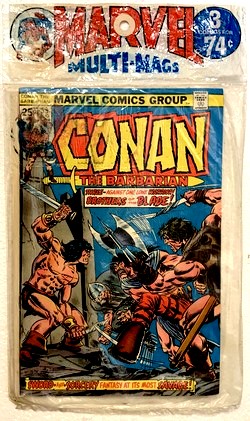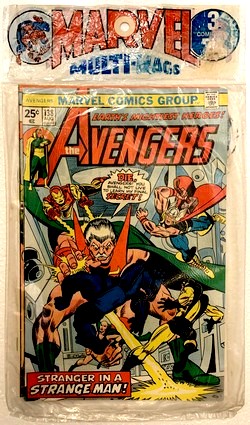 |
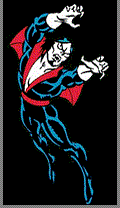 |
|
CONAN,
MORBIUS & THE AVENGERS
BACK
TO BACK IN A
AUGUST
1975 MARVEL MULTI-MAGS
|
|
|
|
| |
|
| |
|
| |
|
| |
MARVEL
MULTI-MAGS |
|
Even in the early
1960s, the comic book industry
realized that in spite of the
hugely successful comeback of the
superhero genre (which had been
clinically dead for most of the
1950s) and the subsequent streak
of new creativity and enthusiasm
it generated, its traditional
sales points were fading away.
Small stores that had carried
comic books were pushed out of
business by larger stores and
supermarkets, and newsagents
started to view the low
cover prices and therefore tiny
profit margins comics had to
offer as a
nuisance. Many ideas on how
to turn these developments around
were put forward by different
publishers, but the most
successful concepts strived to
open up new sales opportunities
and markets and thus tap into a
new customer base.
|
|
|
|
| |
| One place
these potential buyers could be found was the growing
number of supermarkets and chain stores. But in order to
be able to sell comic books at supermarkets, the product
would have to be adjusted. |
| |
|
Handling
individual issues clearly was no option for these
outlets, but by looking at their logistics and
display characteristics, DC Comics (who came up
with the Comicpac concept in 1961) found
that the answer to breaking into this promising
new market was to simply package several comic
books together in a transparent plastic bag. This
resulted in a higher price per unit on sale,
which made the whole business of stocking them
much more worthwhile for the seller. The simple
packaging was also rather nifty because it
clearly showed the items were new and untouched,
while at the same time blending in with most
other goods sold at supermarkets which were also
conveniently packaged. |
|
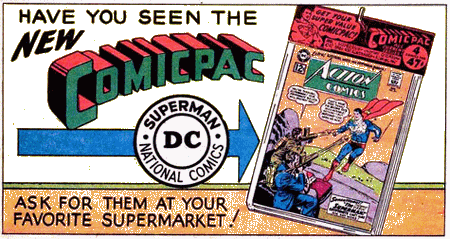 |
|
| |
| Outlets were even supplied with
dedicated Comicpac racks, which enhanced the
product appeal even more since the bags containing the
comic books could be displayed
on rack hooks in an orderly and neat fashion. |
| |
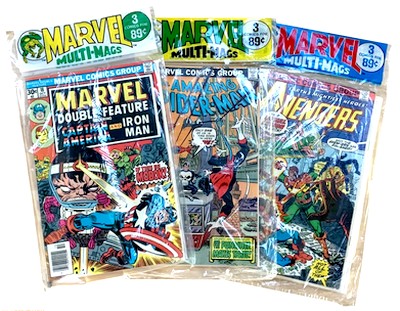
|
|
DC's
"comicpacks" were a success -
so much so that other publishers quickly
started to copy it. Marvel produced a
series of Marvel Multi-Mags in
1968/69 but then seems to have dropped
the idea again.
However,
by the mid-1970s, the House of
Ideas had once again fully embraced the
marketing concept of selling multiple
comic books packaged in a sealed plastic
bag to a customer base which comic books
could hardly reach otherwise: people
shopping at supermarkets and large
grocery stores.
It didn't really
matter therefore that buying these three
comic books in a comicpack for say 89¢
(rather than from a newsagent for 90¢ in that case) clearly presented no
real bargain - it was the opportunity and
convenience to pick up a few comics at
the same time parents and adults did
their general shopping. Neatly packaged,
it almost became an entirely different
class of commodity.
|
|
|
| |
|
| |
| The MARVEL MULTI-MAGS we are
looking at here features Conan #53, Fear #29,
and Avengers #138, all from the August 1975
cover date run. This meant that they were actually on
sale at newsagents in May 1975, although there could be
quite a delay in terms of actual availability of MARVEL MULTI-MAGS at some sales points,
resulting in Multi-Mags on display that contained "semi-recent
books (typically about nine months old)"
(Brevoort, 2007). Considering the packaging and
distribution process, this doesn't really seem too
surprising. There
is no general rule as to what shape/grade the comic books
in a MARVEL
MULTI-MAGS (or any other
comic pack for that matter) will be in; after all, a lot
of things can go wrong during their 40+ years of storage.
Some of these potential mishaps will only affect the
plastic bag, as in the case of this example. There is
noticeable (and somewhat typical) wear in the form of
slight mechanical abrasion, some dulling of the plastic, and
colour ink transfer from when the label was turned back
onto the bag during some time of storage. None of this,
however, affected the comic
books inside.
|
| |
| No titles had
permanent slots in the MARVEL MULTI-MAGS. There were some reliably regular ones (such as
the Avengers from this example), some that
showed up every now and then (e.g. Conan), and
others that only ever featured once or twice throughout
the existence of
MULTI-MAGS (e.g. Fear). But even
with the fairly regular titles (other examples were Hulk,
Thor, Fantastic Four and Amazing
Spider-Man) there was never any guarantee of an
uninterrupted flow of consecutive issues - and therefore
a distinct possibility of missing out on a part of the
storyline. On top of this, the continuity of the Marvel
Universe of the 1970s was such that plots and storylines
usually evolved over more than one issue. This
didn't exactly make the MULTI-MAGS
an ideal way of getting your Marvel comic book fix. However, one needs to bear in mind that
this was a common fate of the average comic book reader
in the 1970s Bronze Age, whether his or her comic books
came packaged in a plastic bag or as single issues from a
display or spinner rack. Back in those days, an
uninterrupted supply of specific titles was, quite
simply, not guaranteed. Not worrying too much about
possible gaps in storylines thus became something of a
routine - besides, you would usually get a recap of
"what happened so far" on the first page.
So all in
all it simply was a part of being a comic book fan in the
1970s - as were the monthly Bullpen Bulletins (which were
the responsibility of the editor-in-chief) and the
in-house advertising (often with mouth watering cover
reproductions).
|
| |
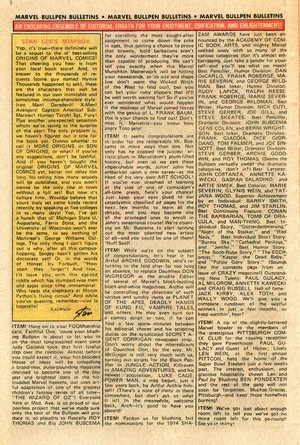 |
|
|
In August 1975, the
Bullpen Bulletin was still on its way
through the alphabet as far as its title
was concerned, arriving at the letter E -
which resulted in the typically
alliterative and somewhat nonsensical
title "An Endearing Ensemble of
Editorial Errata for your Enjoyment,
Edification, and Enlightenment!". The headline item of
Stan Lee's Soapbox column was
the planned sequel to the massively
successful Origins of Marvel Comics.
Besides musings as to the title of said
book, Stan "the Man" also
managed to mention that he had been
invited to talk at five colleges on five
consecutive days. All of this exposure to
academia did not, however, prevent Lee
from misspelling Monty Python as
"Monte", along with an obvious
typo ("in case you've
wondering") in the last sentence of
his ramblings...
|
|
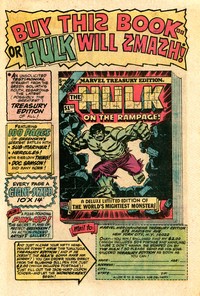
In-house ad from Conan #53
|
As for the
actual Bullpen Bulletins' various
ITEM!
bullet points, they were - as usual - mostly
concerned with new and changing assignments of
various writers, artists, and editors (such as
Archie Goodwin now overseeing Marvel's range of
black and white magazines).
|
|
| |
| A big push was also given to the up and coming
adaptation of The Wizard of Oz - an unlikely
subject matter for the House of Ideas, but one that
readers would be hearing a lot about over the next few
months. There weren't too many
in-house ads that month, but the full-page plug for the Hulk
Treasury Edition #5 certainly was an attention
grabber. Also vying for the attention of readers were the
"promo lines" at the bottom of the story pages;
a somewhat more subtle but often highly intriguing way of
plugging other titles.
|
| |

Promo line from Avengers
#138, page 6
|
| |
| Not surprisingly, this way of
turning otherwise empty space into small advertising
billboards was Stan Lee's brainchild, who first made use
of them way back in 1962 but then dropped the idea again
until he asked Roy Thomas to do something along those
lines in the early 1970s (Cronin, 2019). |
| |
Thomas
obliged for a while and then handed the
task on to others before it ended up
being Scott Edelman's job as of around
1974.
"I
don’t remember exactly how or
when the task was handed over to me -
I assume it had to have been Len
[Wein] who gave me the assignment -
but I would interview the writers
about what they had planned and
create catchy write-ups, the same way
I wrote the Bullpen Bulletins pages
(save for Stan’s Soapbox), the
copy which appeared on top of the
splash page of comics, and other
promotional materials."
(Scott Edelman in Cronin, 2019)
These promo lines
were a small but intriguing part of the
fun of reading Marvel comic books at the
time, since they would quite often
mention characters or titles you had
never heard of before, not unlike the Bullpen
Bulletins and the Mighty Marvel
Checklist.
|
|

Scott
Edelman
|
|
|
| |
| The comic books contained in this
specific MULTI-MAGS fall squarely
into the high tide of the "bottom of the page promo
line" era (the complete promo lines they feature are
listed in the descriptions of the three titles, below). |
| |
| |
|
| |
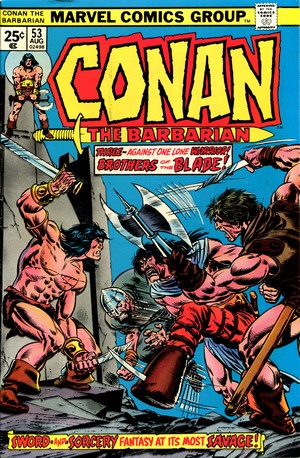
|
|
CONAN
#53
August 1975
(monthly)
On Sale:
20 May 1975
Editor
-Roy Thomas
Cover - Gil Kane (pencils) & John
Romita (inks)
"Brothers of the
Blade!" (18
pages)
Story
- Roy Thomas
Pencils - John Buscema
Inks - Frank Springer
Lettering - John Costanza
Colouring - Janice Cohen
STORY
OVERVIEW
- Conan, Captain
Murilo and Tara leave the city of Ronnoco
with the Crimson Company of mercenaries.
They are being payed to take a princess
en route to her wedding hostage. Conan
ambushes the party headed by the three
brothers Slicer, Steel-Skull and
Clawfoot. Elsewhere, a small detachment
of the mercenaries discovers that
something terrible must have been
unleashed from the mysterious Shadow Ring
they were supposed to retrieve...
|
|
|
| |
|
The adaptation of Robert E.
Howard's Conan the
Barbarian (first published in Weird
Tales Magazine in December 1932) is one of
the big success stories of the House of Ideas Roy Thomas convinced Stan Lee
and then publisher Martin Goodman - although the
initial suggestion came from outside the company:
"Marvel’s readers kept
writing us letters saying we should pick up
the rights to a few of these things that were
coming out in the book stores (...) One thing
they suggested a lot was a sword and sorcery
title, and especially Robert E. Howard and
Conan were being mentioned. I was somewhat
familiar with them and Stan really wasn’t."
(Roy Thomas in NN, 2010)
|
|
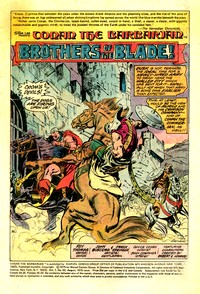 |
|
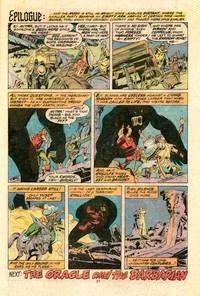 |
|
| |

Roy
Thomas
|
|
Lee told Thomas to write a memo
to Goodman, and the rest is comic book history -
although Conan the Barbarian was
initially off to a disappointing start following
a first issue with a small print run but
excellent sales.
"For a combination of reasons
every one of the next seven issues sold less
well than the one before. (...) It seemed to
be going nowhere fast (...) and then Stan
decided to take a look at the covers (...) “You’ve
got too many animals on the covers” he
said (...) “Get some more humanoid
menacing-looking villains instead" (...)
[so] we had skeletal warriors on the [next]
cover and that issue, #8, picked up in sales
and the next issue, which had a kind of
menacing winged man on it fighting Conan,
that picked up a little more from there and
after that it was never in any kind of danger
of being cancelled for the next fifteen,
twenty years." (Roy Thomas in NN,
2010)
|
|
| |
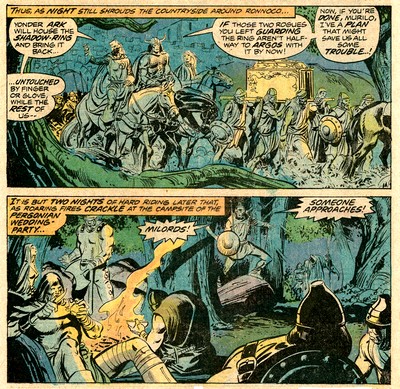
|
|
Conan the
Barbarian had a staggering
run of 275 issues from October
1970 to December 1993 with a very
loyal readership, not the least
due to the long stints of writer
Roy Thomas (who penned issues
#1-115 and #241-253) and
penciller John Buscema (who
provided the art for issues
#25-190).
Conan #53
is very much a set-piece in that
respect, featuring an intriguing
plot, a flowing storyline and
some great artwork which oozes
atmosphere and cinematographic
flow.
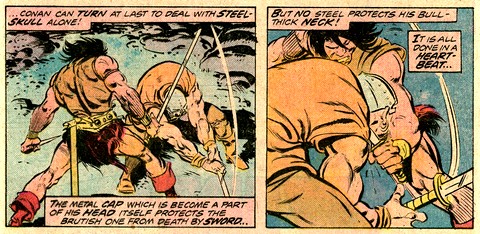
|
|
|
|
| |
"Big" John
Buscema (1927-2002) had a strong affinity
to drawing Conan, and the character
played to the strengths of his
outstanding art.
"[Mythological
stuff and gods and monsters] I
enjoyed - because I don't have the
restrictions of the goddam
automobiles and skyscrapers. I can
create anything that comes into my
imagination. That's why Conan
appealed to me. I had a lot of
freedom in those books. I could do
anything with the buildings and
create costumes. Again, I don't like
drawing mechanical things. I just
don't enjoy it. I like animated
stuff, you know." (John
Buscema in Thomas, 2002)
Not unlike Gene
Colan with Tomb of Dracula,
Buscema made sure he was
he
first artist offered the assignment of
drawing Conan the Barbarian in
1970.
"Conan
was something that hadn't been done
before and I loved the Howard books.
I fell in love with them as soon as I
read them and I was chomping at the
bit and I wanted to do them so
badly." (John Buscema in
Thomas, 2002)
|
|
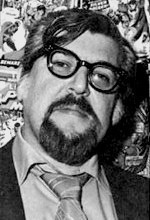
John
Buscema
|
|
|
| |
|
I personally wouldn't actively
seek out Marvel's sword and sorcery material back in the
days, but whenever I chanced upon it, my teenage self
felt that it was good entertainment. The series was
clearly aimed at a more mature audience than Marvel's
average superhero titles of that time, which most likely
is the reason why Conan #53 - an exceptionally
well done issue - has lost nothing of its entertainment
value after almost 50 years. |
| |
 |
|
Regular buyers of
MARVEL
MULTI-MAGS would -
with a little bit of luck - be
able to continue reading the
story of Conan and the Oracle as
Conan #54 would
become available in a MARVEL
MULTI-MAGS the
following month. There is no
letters page in this issue.
The "bottom
of the page promo lines"
featured in Conan #53
are:
|
|
|
|
| |
| DAREDEVIL
- CAUGHT IN THE COILS OF THE COPPERHEAD! NOW ON
SALE! (pg 2) |
| ONLY THE
LIVING MUMMY CAN STAND THE ASSAULT OF THE
ELEMENTALS IN SUPERNATURAL THRILLERS #14!
(pg 6) |
| PULSE-POUNDING
PREMIERE ISSUE - BEFORE THE DAWN OF MAN THERE
STOOD SKULL THE SLAYER! (pg 10) |
| MEET
GLORIAN, "THE MAN WHO CAME DOWN ON A
RAINBOW" - IN THE INCREDIBLE HULK #190!
(pg 14) |
| HOWARD THE
DUCK FACES THE MOST UNEXPECTED VAMPIRE OF ALL IN
GIANT-SIZE MAN-THING #5! (pg 16) |
| THE
TARANTULA'S BACK IN TOWN - AND SPIDER-MAN HAS
HIM! (pg 22) |
| ALL-NEW IN
THE DEAD OF NIGHT THERE LURKS... THE SCARECROW!
NOW ON SALE! (pg 26) |
| MARVEL
SPOTLIGHT #23: THE SON OF SATAN DARES THE
DEATH-TRAP OF DOCTOR DARKLYTE! (pg 30) |
|
| |
| |
|
| |
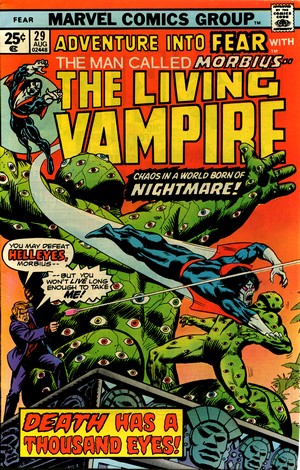
|
|
FEAR #29
August
1975
(bi-monthly)
On Sale:
20 May 1975
Editor -Len Wein
Cover - Ron Wilson (pencils)
& Bob McLeod (inks)
[alterations by John Romita]
"Through a Helleyes
Darkly!" (18
pages)
Story - Bill
Mantlo
Pencils - Don Heck
Inks - Bob McLeod
Lettering - Petra Goldberg
Colouring - Gaspar Saladino (pg
1), Karen Mantlo
STORY
OVERVIEW
- Detective
Simon Stroud continues his
tireless pursuit of vampires in
Boston, and more specifically
Morbius the Living Vampire.
Having discovered that one of
Helleyes's eyes is an
inter-dimensional portal, they
both now find themselves in a
different, strange and hellish
dimension. They soon realize that
they have to team up, at least
for the time being, in order to
get past the ever-watchful gaze
of Helleyes and survive.
|
|
|
|
| |
|
Marvel launched the first issue
of Fear in November 1970 as part of their
attempt to get back into the horror genre. |
| |
| Initially,
the title featured no original material and
simply reprinted monster stories from the late
1950s and very early 1960s that were mostly
written by Stan Lee and Larry Lieber, and
pencilled by Jack Kirby, Steve Ditko and Don
Heck. This made the material
"sellable" for a second time, but there
were limits, and as was the case with other
"reprint anthology titles" of the time,
Fear changed direction after a number of issues.
|
|

Original
Fear cover logo (#1-9)
|
|
| |
|
The series was retitled Adventure
Into Fear as of issue #10 (October 1972), although
the indicia continued to list the title as simply Fear
- a fact which at times leads to some confusion as to the
exact title. |
| |

Adventure
Into Fear cover logo tag (issues #10-31)
|
|
Marvel
only trademarked the title Fear, but the
covers displayed the added tag line
"Adventure Into" for all of the
remaining issues (#10-31), with "Fear"
always appearing in a slightly larger font size
and often highlighted. |
|
| |
| Most importantly, the added tag line to the title
highlighted a change in direction. As of issue #10, Fear
began to feature
new material.
Moved to the title following its introduction in the
black &white magazine format Savage Tales #1
(May 1971), Marvel's swamp creature Man-Thing became the
headline feature for ten issues before moving to its own
title; the Man-Thing's last appearance in Fear
#19 (December 1973) is also notable for the introduction
of Howard the Duck.
Fear
#20 therefore introduced a new feature, and in-keeping
with the title's roots in the horror genre, Marvel
decided to give the floor to Morbius the Living Vampire.
Created by writer Roy Thomas, artist Gil Kane and inker
Frank Giacoia, Morbius made his first appearance in
Amazing
Spider-Man #101 (October 1971). This became possible
after the previously extremely strict Comics Code had
been revised early in 1971 to allow the depiction of "vampires,
ghouls and werewolves (...) when handled in the classic
tradition such as Frankenstein, Dracula, and other high
calibre literary works". Roy Thomas had wanted
to seize upon this new freedom immediately, but since
Stan Lee already had plans for Dracula, had to come up
with an alternative.
"[Stan Lee] was the
one pushing [Tomb of Dracula]. Gil [Kane] and I, of
course, had wanted to introduce Dracula into
Spider-Man #101 earlier, but Stan said, no he wanted
a super-villain vampire, so we made up Morbius, whom
we made not a real vampire." (Roy Thomas in
Cooke, 2001)
|
| |
Dr Michael
Morbius, a Nobel-prize winning biochemist,
attempts to cure his rare blood disease with an
experimental treatment involving vampire bats.
Things don't work out as planned, and he becomes
afflicted with a condition that mimics the powers
and blood thirst of vampirism.
"Morbius was
a science-fictional vampire." (Roy
Thomas in Cooke, 2001)
As a
result, Dr Morbius has to digest blood in order
to survive, feels a strong aversion to light.
"The biggest
influence on Morbius was a circa-1957 b&w
film called “The Vampire,” in which
a man had to kill people and drink their
blood to stay alive, so that he wasn’t a
true vampire at all." (Roy Thomas
in Biscotti, 2020)
|
|
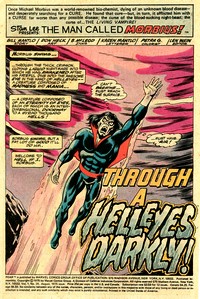 |
|
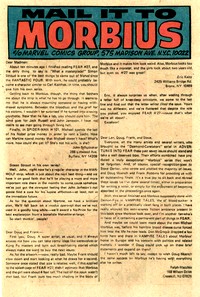 |
|
| |
In addition, his appearance
turns hideous, with his canine teeth extending into
fangs, his nose flattened to appear more like a bat's,
and his skin turning chalk-white. On the up side, he
gains the ability to fly, along with superhuman strength.
The latter certainly corresponds with his general
physical appearance, which mimics supervillain attire - a
clear inheritance from his first appearance having taken
place in the world of Spider-Man.
"Gil [Kane] sketched
out the character with me sitting with him, and we
discussed the general look (…) the costume is
fairly generic (…) and the face is a logical one
for a sort of human vampire bat (...) I came up with
the name Morbius." (Roy Thomas in Biscotti,
2020)
Morbius the Living Vampire thus
became the starring feature as of (Adventure into)
Fear #20 (February 1974) and continued throughout
the remaining run of the title until cancellation after
issue #31 (December 1975).
|
| |
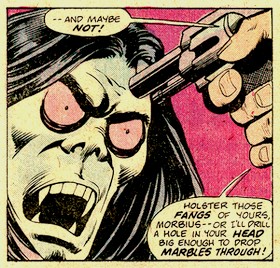
|
|
Unlike his
predecessor Man-Thing, Morbius
lacked direction and consistency
right from the start.
On the
scripting side of things, an
initial issue penned
by Mike Friedrich
was followed by five issues
written by Steve Gerber (who sent
Morbius on an interdimensional
journey fighting surrealistic
characters including an
eyeball-headed character called
"I"), who in turn was
followed for 3 issues by Doug
Moench. Finally, as of Fear
#29, Bill Mantlo took over for
what would turn out to be the
final 3 issues.
In the artwork
department, there was even more
of a revolving door situation as
pencillers (and inkers) came and
went: Paul Gulacy (for 1 issue),
Gil Kane (1), Rich Buckler (1),
Craig Russell (2), Frank Robbins
(4), Don Heck (1), George Evans
(1), and finally Frank Robbins
again for the final issue. Given
that these artists also represent
pronounced differences in style,
there simply was no visual
consistency as a result.
|
|
|
|
| |
This lack of consistency is partly due to the fact
that Fear was a testing ground. If an experiment
went well (such as Man-Thing), writers and artists would
be more likely to be assigned in a regular pattern and
ultimately move on with the character to their own title.
However, if sales figures didn't really warrant major
attention, things turned into a merry-go-round quickly.
"We did some
horror/mystery things in the early 70s, but we knew
some of them would sell and some of them wouldn't. So
we put out 20 or 30 books. It was really the old,
same policy that Martin Goodman had (...) if one
horror comic sells, the next month there were 20 of
them. If you had Dracula, then you had to have
Werewolf by Night, and you had Morbius, and you had
Man-Wolf, and you had the Living Mummy, and you had
Dr. Voodoo. And some of those characters are going to
sell and stick around, and some aren't."
(Roy Thomas in Barnhardt, 2021)
|
| |
| In this respect, Fear
#29 has all the signs of a title bound for cancellation -
one of them being the assignment of Bill Mantlo. |
| |
Mantlo's early
work at Marvel included a short stint as
colourist but he soon transitioned to being a
writer, becoming Marvel's "fill-in
king" of the 1970s.
"I
would write any character quickly and, while
my plotting was weak, everyone liked my
dialogue (...) but I seemed to get passed
over for a regular title (...) I was given
other titles (Frankenstein, Morbius) but they
were mags that were near cancellation anyway,
and failed even before I could get
started."
(Bill Mantlo, in
N.N., 1979)
Handing the title to
"Boisterous" (his bullpen nickname)
Bill Mantlo was therefore just a case of finding
a free writer, with no reputation to lose, for a
title bound for cancellation unless nothing short
of a miracle happened - something editor Len Wein
would almost be begging for on the letters page of the next issue under the title "HELP!!
the Living Vampire is dying!"
|
|

Bill
Mantlo
|
|
| |
| It was to no avail. Mantlo would
go on to become an established writer, penning much loved
runs on Iron Man and the Hulk, as well as leaving his
mark on the Micronauts. But his plot for Fear
#29 is simply a detour which has Morbius and Simon Stroud
end up right where they started next
issue, back in Boston's haunted Mason Manor, with
precious little consequence for the overall story. |
| |
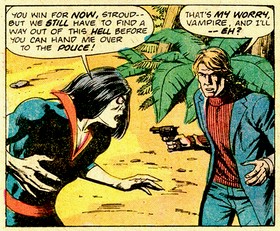
|
|
The artwork of Fear
#29 - which is very loose all
over and bordering on awful in
far too many panels - also speaks
volumes about how much of a
rushed job this must have been.
Don Heck, who pencilled this
issue and who had been
responsible for some of Marvel's
most classic artwork of the
1960s, had since found his role
at the House of Ideas had
changed.
"He
got the nickname "Don
Hack" but people forget
that it was Heck that a lot
of editors went to when they
needed an entire book over a
weekend. The inkers would
then have to rush through the
job too. Then those same
editors would complain about
the work. Well, just how
great are 22 pages going to
be when you only have a
couple of days to draw
them?" (Jim Amash
in Coates, 2014)
|
|
|
|
| |
| Overall, Fear #29 is
simply a terrible disappointment on all levels - but
Mantlo and Heck (the latter left Marvel in 1977 for
greener pastures over at DC) as well as inker Bob McLeod
are hardly to blame. |
| |
 |
|
The
saving grace for Fear
#29 from todays collector's
perspective may be the fact that
this only one of two issues of
this title known to have been
included in a MARVEL
MULTI-MAGS (the other
being Fear #10 in an
October 1972 four-pack). The "bottom
of the page promo lines"
featured in Fear #29
are:
|
|
|
|
| |
| THE
TARANTULA'S BACK IN TOWN - AND SPIDER-MAN HAS
HIM! (pg 2) |
| MARVEL
SPOTLIGHT #23: THE SON OF SATAN DARES THE
DEATH-TRAP OF DOCTOR DARKLYTE! (pg 6) |
| ONLY
MARVEL WOULD BE CRAZY ENOUGH TO PUT TOGETHER A
BOOK THAT WOULD MAKE YOU GO "ARRGH!"
(pg 10) |
| IT'S A
"NIGHTMARE IN NORWAY" AS JOHN KOWALSKI
LEARNS THAT WAR IS HELL! (pg 14) |
| CAPTAIN
AMERICA #188: "DRUIDWAR" - AND THE
ALCHEMOID SHOUTS DEATH! (pg 16) |
| KOLCHAK
MOVE OVER! POWER MAN FACES... "THE NIGHT
SHOCKER!" (pg 22) |
| TERROR
TIMES THREE AS CONAN FACES THE "BROTHERS OF
THE BLADE!" (pg 26) |
| "HELL
HATH NO FURY" - LIKE A DRACULA SCORNED!
(pg 30) |
|
| |
| |
|
| |
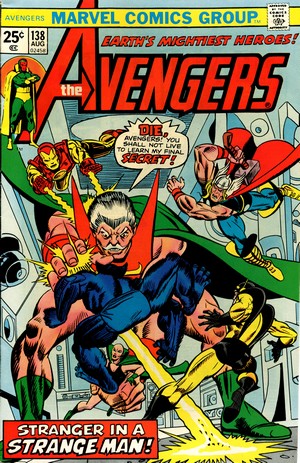
|
|
AVENGERS #138
August
1975
(monthly)
On Sale:
20 May 1975
Editor - Len Wein
Cover - Gil Kane (pencils) &
Mike Esposito (inks)
"Stranger
in a Strange Man!"
(18 pages)
Story
- Steve Englehart
Pencils - George Tuska
Inks - Vince Coletta
Lettering - Charlotte Jetter,
Gaspar Saladino (Splashpage)
Colouring - George Roussos
STORY
OVERVIEW
- The
Wasp is rushed to hospital
following an attack on the group
by The Stranger, who was seeking
out the Scarlet Witch (who is on
her honeymoon with Vision in an
unknown location). Yellowjacket
heads a team of Avengers to the
Stranger, whose inconsistent
abilities baffle them until their
final confrontation aboard the
Strangers ship where he is
revealed, thanks to the Beast's
ingenuity, not to be the Stranger
at all but rather the Toad in
disguise. Easily defeated, it
turns out that he stole the
Stranger's technology in order to
get back at the Scarlet Witch for
turning down his romantic
advances.
|
|
|
|
| |
| At this point in the Avengers' publication history,
Steve Englehart had just wrapped up the "Celestial
Madonna" story arc, linking the origins of Mantis to
the Kree-Skrull conflict, depicting Kang and Immortus as
being past and future versions of each other, and
revealing the Vision's body to originally having belonged
to the 1940s Human Torch, giving him enough certainty
about his origins to propose to the Scarlet Witch, the
subsequent wedding being presided over by Immortus. Firing up a new storyline, Englehart
had expanded the line-up of the Avengers by having the
Beast and Moondragon join the team in the previous issue,
Avengers #137 (July 1975).
After the Mantis epic, it was
time to revamp the team. Among other changes, I
brought in the Beast, my first character - there was
still no X-MEN book at this time - and he bonded so
well with the Avengers (...) Also introduced was
Moondragon, a creation of Jim Starlin's who'd ended
up in the Mantis epic as the loser in the Celestial
Madonna sweepstakes. She lacked Mantis's humanity,
but maybe hanging with the Avengers would muss her up
a little. Or not..." (Englehart, 2020)
The focus for the next few issues
is very much on Yellowjacket and his emotional struggle
due to the Wasp being in a coma.
|
| |
|
In that respect, Avengers
#138 presents something of an interlude, with the
Toad impersonating the Stranger and raising the
question of where exactly Vision and the Scarlet
Witch (both still active Avengers but currently
on their honeymoon) actually are. The next issue, Avengers
#139, returns the spotlight to the hospital and
the Wasp, before the Vision needs to enter
Yellowjacket's body in Avengers #140 in
order to save Hank Pym's life.
After all of that,
Englehart would launch another multi-part story
featuring the Squadron Supreme (Avengers
#141-148, May 1975 to July 1976) which would also
include some time travel (to the year 1873, to be
exact) in search of Hawkeye by Thor, Moondragon
and Immortus as well as the Avengers travelling
to "Other Earth".
|
|
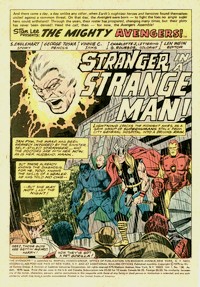 |
|
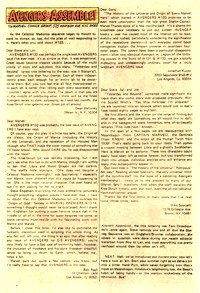 |
|
| |
| Steve Englehart (b. 1947) had
taken over the sripting of The Avengers as of
issue #105 (November 1972) from Roy Thomas - who had been
instrumental in recruiting Englehart. |

Steve
Englehart
|
|
"Roy Thomas made
AVENGERS into, arguably, Marvel's top book -
one I admired tremendously. And then he
became Marvel's Editor-in-Chief and handed
the title off to...me. (...) I spent the
first part of my run trying to do Roy Thomas
stories, and feeling that I was missing the
mark. Sales were good but I, an AVENGERS fan,
felt less than happy with what I, the
AVENGERS writer, was producing. Then in #112,
I introduced a new character named Mantis.
And very soon thereafter I was doing Steve
Englehart stories, which turned out to work
much better for me..." (Englehart,
2020)
"When [Roy
Thomas] became Editor-in-Chief himself, he
let us new writers be completely ourselves.
That single decision allowed the great leap
forward we took in the 70s, so there’s
no overstating how crucial that was. (...)
And of course, he decided that I could write
in the first place. What was interesting to
me, after he gave me Avengers, was that he
liked to start with a plot and add character,
while I started with character and added
plot. Nevertheless, we both understood what
made fun comics and tried to end up there
every time." (Steve Englehart in
Klaehn, 2020)
|
|
| |
| The pencils for Avengers #138
were provided by George Tuska (1916-2009), a seasoned
comic book industry veteran who had started out back in
1939 with Fox Comics. |
| |
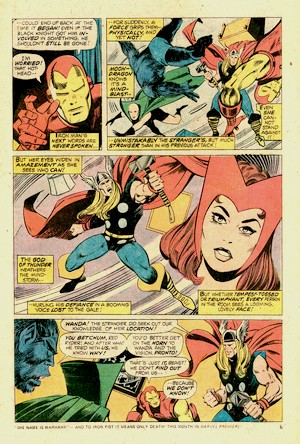
|
|
|
His first
work at Marvel Comics was
for Tales of Suspense #58
(November 1964),
pencilling the last
"Tales of the
Watcher" feature to
appear in that title, and
then went on to truly
leave his mark on Iron
Man, a character he first
drew for Iron Man
#5 (September 1968). Tuska
would
ultimately pencil Iron
Man for a period of
almost 10 years (with a
few brief interruptions
here and there), during
which time he developed
and shaped the visuals of
the character into the
iconic look of Iron Man
for the entire Bronze
Age. But he was
also a very versatile
artist who seemed to be
at home with any
character(s) and genre
editors could throw at
him.
|
|

George
Tuska |
"He
could do everything. When
Stan knew that a guy could do
anything, he used him in
every possible, conceivable
way. George was a helluva
artist and very versatile and
very fast (...) He was in
demand." (John
Romita Sr in Cassell, 2005)
Right
after becoming a Marvel Bullpen
regular in 1967, one of George
Tuska's first jobs was to ink
John Buscema's pencils on a few
issues of the Avengers.
It
wouldn't turn out to be one of
Tuska's regular titles, but he
did provide the artwork for a
number of Avengers
issues, including #137–140
(the others were #47–48, 51,
53–54, 106–107, 135,
and 163).
|
|
|
|
| |
|
His experience with
Iron Man clearly shows, but his acute artistic
sense for composition and the dynamics of a page
really becomes evident with a group title. In
that respect, getting Tuska to pencil a few
issues of the Avengers was an easy
decision to make for any editor, and he was an
artist who would gladly oblige if at all
possible. For Avengers
#138, Tuska provided a steady flow of dynamic
visuals, and many of the panels contained in that
issue could easily be taken out of context, blown
up, and hung on a wall - as iconic examples of
1970s superhero comic book art.
"[George
Tuska] was very dependable, you didn't have
to talk to him very often (...) because first
he was a good artist, and secondly, Stan
[Lee] had kind of indoctrinated him. by the
time I took over as editor he knew the ropes.
We kept him very busy at the time."
(Roy Thomas in Cassell, 2005)
"[George
Tuska's] layouts were certainly more
imaginative than the standard at the time,
and the way in which characters (...) held a
lot of their strength in their shoulders and
punched from their legs up through their
torsos betrayed his knowledge of strength and
fitness. His signature flourish may have been
characters in arrested motion, coiled in
preparation for violence (...) legs splayed
in the form of a near-base ready for what
might come next. Tuska cemented his
reputation as one of the more iconic
superhero artists of [the 1970s] - two full
generations after entering comics."
(Spurgeon, 2009)
|
|
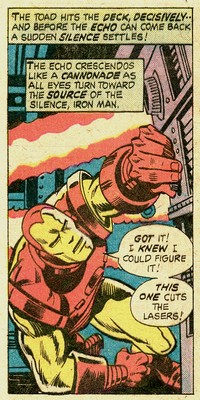 |
|
| |
 |
|
Regular buyers of
MARVEL
MULTI-MAGS would -
with a little bit of luck - be
able to continue reading the
story as
Avengers #139 would
become available in a MARVEL
MULTI-MAGS the
following month. The "bottom
of the page promo lines"
featured in Avengers
#138 are as follows (including an
outdated plug for Conan
#52):
|
|
|
|
| |
| THE
FRANKENSTEIN MONSTER GAINS THE POWER OF SPEECH
AND MUST FACE "A PHOENIX BERSERK"!
(pg 2) |
| "THE
NAME IS WARHAWK" - AND TO IRON FIST IT MEANS
ONLY DEATH! THIS MONTH IN MARVEL PREMIERE!
(pg 6) |
| HE-WHO-RIDES-THE-NIGHT-WINDS
LIVES AGAIN IN THE PAGES OF GIANT-SIZE KID COLT
#3! (pg 10) |
| THE
UNCANNY ULIK WANTS TO CONQUER THE UNIVERSE - AND
ONLY THE MIGHTY THOR CAN STOP HIM! (pg 14) |
| SPIDER-MAN
ASKS "SCORPION, WHERE IS THY STING?",
AND ONLY DEATH HOLDS THE ANSWER! (pg 16) |
| CONAN #52:
ALONE, THE MIGHTIEST BARBARIAN OF ALL MUST FACE
"THE GOD IN THE CRYPT"! (pg 22) |
| IN PLANET
OF THE APES #9. THE ORDER GOES FORTH: DESTROY ALL
HUMANS! (pg 26) |
| BE THERE
WITH KILLRAVEN ON "THE DAY THE MONUMENTS
SHATTERED" - IN AMAZING ADVENTURES #31!
(pg 30) |
|
| |
| |
|
| |
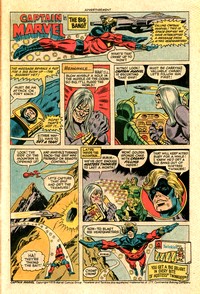
Twinkies
ad, from Conan #53
|
|
|
|
| |
|
| |
BIBLIOGRAPHY
| |
| |
|
BARNHARDT
Adam (2021) "Marvel
Legend Roy Thomas on His Storied Comics Career,
the Future of Comic Book Movies, and More", published online
2 November 2021 at comicbook.com
BISCOTTI Steven
(2020) "Vampires & A Monster
Called Morbius: A Conversation with Roy Thomas", published online
23 November 2020 at universalmonstersuniverse.com
BREVOORT
Tom (2007) "Marvel Multi-Mags", Blah Blah
Blog, originally published online 28 April
2007, reposted 18 April 2020
CASSELL
Dewey (2005) The Art of George Tuska,
TwoMorrows Publishing
COATES
John (2014) Don Heck - A Work of Art,
TwoMorrows Publishing
COOKE Jon
B. (2001) "Son of Stan: Roy's Years
of Horror", in Comic Book Artist #13
CRONIN
Brian (2019) "Who
Wrote The 'Bottom Line' Promos in Marvel Comics
in the 70s?", published online
8 February 2019 at CBR.com
ENGLEHART
Steve (2020) "The Avengers I: 105-152", published online
25 February 2020 at steveenglehart.com
HOWE
Sean (2012) Marvel Comics - The Untold Story,
Harper Collins
KLAEHN
Jeffery (2020) "'I like Superheroes the
best' - An Interview with Steve Englehart", published online
21 September 2020 at The Comics Journal tcj.com
N. N.
(1979) "Bill Mantlo and the
Micronauts", originally published in BEM #24
(July 1979), available online at innerspaceonline.com
N.N. (2010)
"Roy Thomas on the History of
Conan",
published online at ICv2, 14 October 2010
SPURGEON
Tom (2009) "George
Tuska, 1916-2009", in Comics
Reporter (16 October 2009)
THOMAS
Roy (2002) "An
Avengers Interview--Sort Of--with John Buscema",
in Alter Ego Vol. 3 #13, March 2002
|
|
| |
| |
|
| |
| |
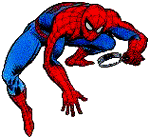

(c) 2022
uploaded to the web
20 March 2022
minor corrections added 11 February 2023
|
| |
|
| |
|


